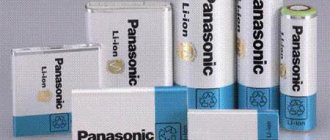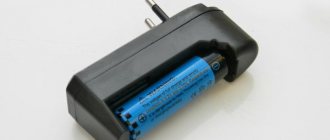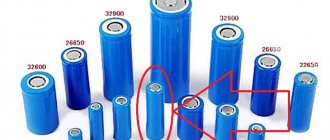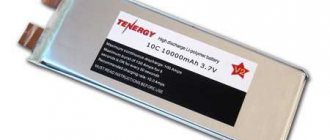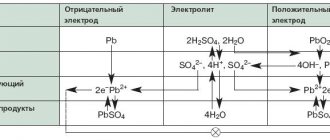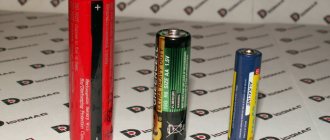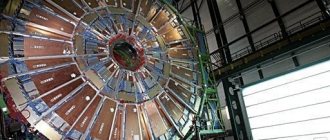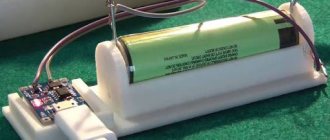The mobility of modern electronic devices is ensured by a lithium-ion battery. This type of battery simultaneously combines compact size, large capacity and a good price. There is an innovative lithium-polymer battery that has better performance, but the high cost is still forcing manufacturers in Russia to look towards the Li-Ion analogue. In order for a lithium battery to last for several years, it is important to know the basic rules of operation and charging, and the principle of operation.
Lithium-ion batteries have a high capacity with a compact body size.
Features of the production of lithium-ion batteries
Battery device.
A lithium-ion battery consists of electrodes separated by separators into which electrolyte is poured. The structure is placed in a completely sealed housing, excluding access to moisture, air, cathodes and anodes are connected to current leads through which current is transmitted to the device. A valve is provided on the housing to relieve excessive pressure resulting from a sudden temperature change or violation of operating rules.
The first generations of lithium batteries were prone to explosions. Therefore, for a long time, nickel-cadmium batteries were used, which did not have this problem. However, NiCds are not capable of providing long-term autonomy for new generation devices, which require the battery to be both compact and have increased capacity, current, and voltage parameters. LiIon has twice the energy density of NiCd.
In the future, through the use of advanced active materials, the power will be further increased; they will work three times longer than power supplies based on outdated technology.
Charging procedure
In Li-ion combined charging, it consists of 2 cycles. First, electric current flows continuously to a certain value for 40 minutes, then voltage is also supplied for up to 1.5 hours. In pulse mode, the drive charges faster.
During use, a number of restrictive conditions are observed:
- the battery capacity is 2 times less than the discharge current - with a value of 2100 mAh, a current of 4200 mA is allowed;
- the mark cannot be lowered below 2.3 volts;
- Overcharge should not exceed a voltage of 4.4 V.
The battery life is extended by preparing the batteries for use. Its speed and duration is ensured by a controller with the correct calibration and storage module.
It promptly restores lost energy. If the manufacturer did not install this element, the battery was created from several parts, and the supply components are not balanced during discharge, the voltage will equalize when the battery is fully charged. In lithium-ion devices, the balancer regulates voltage and current in individual segments.
Design and principle of operation of the battery
A lithium ion battery cell consists of positive and negative plates. The cathode is created from lithium derivatives (several varieties are used in production) on aluminum foil, the anode is made of graphite on copper foil. A porous separator is installed between the plates. It is impregnated with an electrolyte that acts as a conductor. The charge is transferred by lithium ions, which are easily integrated into the porous carbon lattice, which causes chemical reactions. reaction.
The above-described scheme is rolled up and placed in a sealed case made of aluminum, steel, and polymers.
Accumulation, storage, and transmission of current is carried out according to the following principle:
When voltage is applied to the electrodes, lithium ions are detached from the cathode, pass through the separator to the graphite anode and are built into its molecular structure. As a result, an oxidation reaction occurs and the battery is charged. When a load is applied, lithium ions move back to the cathode. The carbon plate on copper foil becomes a “minus”, and the lithium derivatives on aluminum become a “plus”.
Principle of operation.
Is it permissible to charge Lithium-ion batteries at sub-zero temperatures?
It is strictly not recommended to charge lithium energy sources in the cold. After the drive has worked at sub-zero temperatures, it must be heated in the room. But the equipment needs to be warmed up naturally, gradually. Do not place it near heat sources.
What is the best temperature to charge at? The optimal range is +10…+25 degrees. If the drive is charged in the cold and brought into a warm room, it will be overcharged. Overcharging, in turn, like extreme discharge, has a detrimental effect on the efficiency of the batteries and their life expectancy.
Main characteristics
Among the main advantages of Li-Ion batteries:
Pros and cons of batteries.
- low self-discharge;
- increased capacity;
- great tension.
- low resistance;
- there is practically no memory effect;
- 400-500 charge-discharge cycles.
Among the negative points:
- fire hazard;
- the need to install a controller;
- susceptibility to aging;
- impossibility of use at low temperatures.
Impact factors
When the battery life is completely exhausted, the capacity volume is reduced to a position equal to the technical parameters, the element is changed. The energy source capacity level set by the manufacturer may decrease or increase during practical use. Deviations and service depend on the correct:
- storage;
- care;
- temperature conditions;
- charging mode;
- discharge depth.
If all rules are followed, the battery will last at least 7 years or 1000 charge-discharge cycles.
Areas of use
Energy storage technology based on lithium-ion batteries has been in use for several decades, but has never reached its peak potential. Batteries are widely used not only in everyday life, but also in industry. For example, lithium-ion batteries are used in cars, airplanes, and watercraft.
The Boeing Corporation is constantly improving battery production technologies, creating sizes that can operate in an expanded temperature range. The latest innovation is a change in design, reducing heat generation parameters.
The charging system is also being improved, mainly due to the installation of advanced controllers that can determine, check the current current supply parameters, and limit them if necessary. This ensures a gentle charging mode and eliminates battery failure, which is critically important on an airplane. As a rule, new technologies used in the aviation and space industries are eventually exported to household appliances, providing users with high-quality, safe power sources.
Another powerful breakthrough was the emergence of modern electric vehicles, where Tesla is the leader. Its engineers have created ultra-powerful lithium-ion batteries that provide a range of up to 500 km, which puts electric vehicles and internal combustion engines on par.
Tesla lithium-ion battery.
Norway operates ferries that are propelled by electric motors powered by lithium-ion batteries. The carrying capacity of one vessel is 360 passengers and 120 cars.
Another area of application for batteries based on lithium-ion technology is helicopter construction. For example, an electric helicopter from the Japanese company Hirobo takes one passenger on board and reaches speeds of up to 100 km/h. When the battery is fully charged, the silent engine, which does not emit CO2 into the atmosphere, can operate for more than half an hour.
The development of battery production technology is moving towards increasing capacity, increasing power, while simultaneously reducing dimensions and cost. The use of silicon nanoconductors instead of graphite in anodes will help reduce charging time to 15 minutes with a threefold increase in capacity.
Standard parameters
All types of lithium-ion batteries have typical characteristics, regardless of their composition and scope of use. They are as follows:
- The total charging time for the device is from 2 to 4 hours.
- The number of cycles: discharge/charge when reaching 20 percent of the battery capacity ranges from 500 to 1000.
- The minimum voltage varies from 2.2 to 2.5 V.
- The maximum voltage is from 4.25 to 4.35 V.
- At normal room temperature, the self-charge of the device is about 7% per year.
- The temperature range within which the battery can function properly ranges from 20 to + 60 degrees.
It is best to familiarize yourself with the technical parameters of the battery in advance. This will help avoid mistakes when using a lithium-ion battery and increase its service life.
General rules for using Li-Ion batteries
To ensure that the current-voltage and other characteristics do not decrease, it is important to properly operate the lithium-ion battery. The first charge is important, allowing you to correctly print the preserved battery. The device should be charged after it is completely discharged; it is recommended to repeat the procedure 2-3 times. Thus, the “memory effect” is eliminated; the battery will be used to the full capacity declared by the manufacturer.
It is important to monitor the temperature conditions at which a smartphone, laptop, or other portable equipment is used. The lithium-ion power source is sensitive to both high temperatures (it can ignite and explode) and low temperatures (consumer properties can significantly deteriorate).
Charger
Charging the battery in a smartphone.
Experts recommend replenishing the battery capacity when the value of 30-50% appears on the screen. The included power supply contains a controller that will stop supplying current when the battery is fully charged. This protects the battery from overheating, but does not guarantee that the battery will not begin to degrade if it is left plugged in for several days.
Do not charge a battery that has recently been operated at its maximum capacity. If the device lid gets a little hot, it is recommended to wait 15-20 minutes before connecting the charging unit to the outlet.
It is not recommended to use a non-original charger or a homemade device. Absence, incorrect operation of the controller, charging with incorrect current values is fraught with smoke, fire, or explosion.
Calibration
If the user notices that the battery is no longer performing as well as before, it is recommended to perform a calibration. The procedure will help reduce the level of self-discharge, a drop in plate capacity, and extend the overall life of the battery. Ideally, calibration should be done every three months. There are two options: manual or software. But in any case, the procedure consists of sequential charging and discharging of the battery, it is repeated 2-3 times.
This scheme of actions restores normal operation of the controller and resets the “memory effect”. If calibration is performed using a software method, the user additionally receives information about the performance of the battery, for example, the degree of wear of the plates.
Storage
Lithium-ion batteries require special storage conditions, especially if the battery is not used for more than six months. In such a situation you will need:
Battery storage temperature.
- Fully charge the battery.
- Remove it from the device.
- Place in a dry, cool place where there is no possibility of direct contact with sunlight.
It is optimal when the room temperature is 15-17 degrees. Under such conditions, the battery practically does not undergo self-discharge and retains its original performance characteristics.
Normal storage temperature is 15-17°C - with such parameters, the battery will minimally self-discharge and retain its consumer properties. Full recharging of the battery must be repeated every 3-4 months.
Conditions for safety
There are several simple rules, the observance of which can increase the performance of Li-ion:
- the battery and device must be from the original manufacturer;
- full charging is carried out immediately after purchase, the manufacturer charges the battery halfway to avoid losses during transportation;
- work with the device in a limited temperature regime, without increasing to + 30 degrees, without dropping to – 20 degrees. You cannot overcool or overheat it.
- do not allow complete discharge, use the device at 10% - 90% of the filled volume of the container;
- If you have to leave the battery for a long time, it is charged to 50%.
The service life also depends on storage. You can’t just take the element out and put it on a shelf; the container will shrink due to long periods of inactivity. Only after the charge level is at least 40%, the device is tightly packed and placed in a cold place.
Disposal
These batteries contain heavy metals and other elements that are hazardous to human and animal health, as well as the environment.
Therefore, lithium batteries must be recycled and cannot simply be thrown away. The waste contained in lithium batteries can be classified as the second hazard class. In addition, due to the presence of active lithium in their composition, these batteries have more than once caused fires in landfills and waste storage areas.
Fortunately, today there are all the necessary technologies and equipment for the neutralization and recycling of Li─Ion and Li─Pol batteries. In general, the battery recycling process includes two main stages:
- Extraction and neutralization of electrolyte;
- Sorting of solids (metal, plastic) and their grinding.
To get an idea, you can read about recycling car batteries. In Russia, the waste recycling market in general and the recycling of lithium batteries is gradually developing. You can hand over your lithium batteries at collection points for such waste or at your housing and communal services department.
